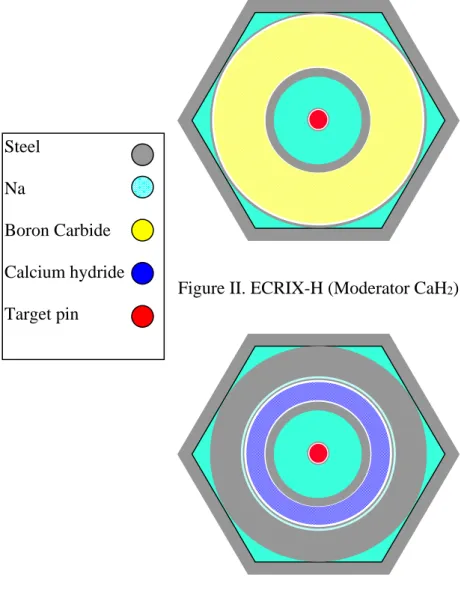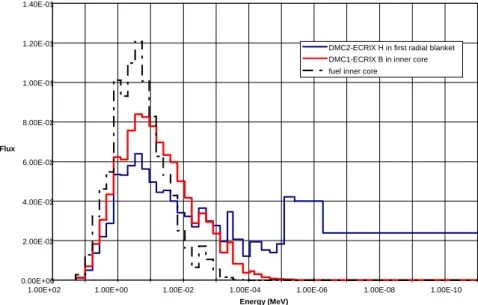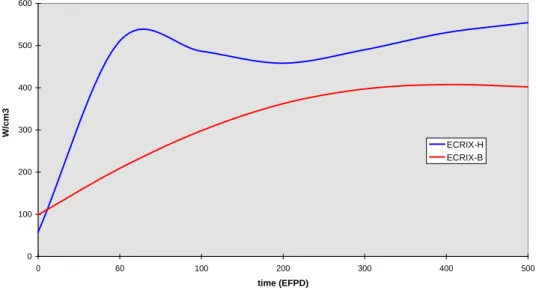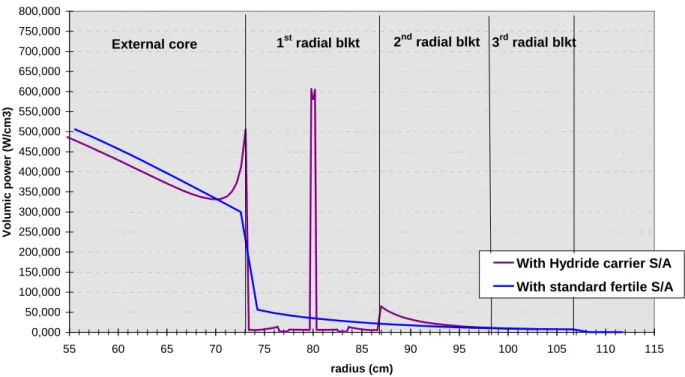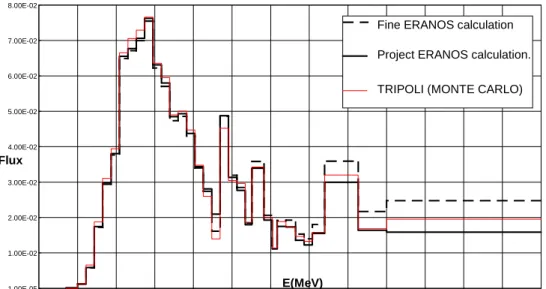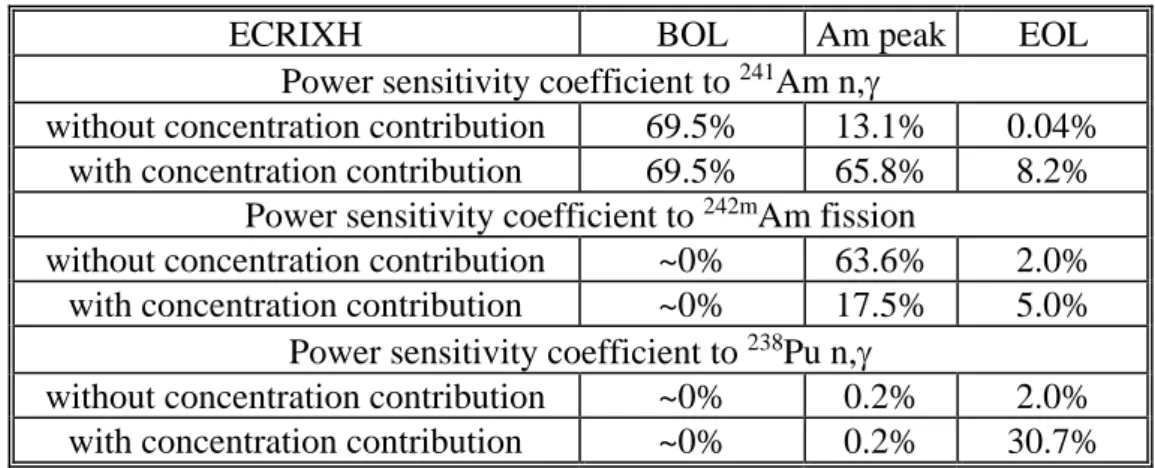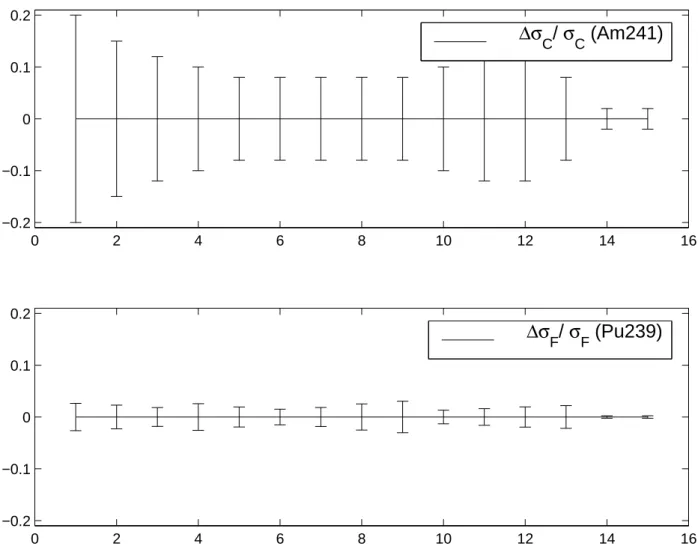HAL Id: cea-02906384
https://hal-cea.archives-ouvertes.fr/cea-02906384
Preprint submitted on 24 Jul 2020HAL is a multi-disciplinary open access archive for the deposit and dissemination of sci-entific research documents, whether they are pub-lished or not. The documents may come from teaching and research institutions in France or abroad, or from public or private research centers.
L’archive ouverte pluridisciplinaire HAL, est destinée au dépôt et à la diffusion de documents scientifiques de niveau recherche, publiés ou non, émanant des établissements d’enseignement et de recherche français ou étrangers, des laboratoires publics ou privés.
UNCERTAINTIES ASSOCIATED TO THE USE OF
THE ERANOS CODE SYSTEM WHEN APPLIED TO
THE MODERATED ECRIX IRRADIATIONS IN THE
FAST REACTOR PHENIX
Frederic Varaine, C. de Saint-Jean, G. Rimpault
To cite this version:
Frederic Varaine, C. de Saint-Jean, G. Rimpault. UNCERTAINTIES ASSOCIATED TO THE USE OF THE ERANOS CODE SYSTEM WHEN APPLIED TO THE MODERATED ECRIX IRRADI-ATIONS IN THE FAST REACTOR PHENIX. 2020. �cea-02906384�
UNCERTAINTIES ASSOCIATED TO THE USE OF THE ERANOS CODE
SYSTEM WHEN APPLIED TO THE MODERATED ECRIX
IRRADIATIONS IN THE FAST REACTOR PHENIX
F. VARAINE, C. DE SAINT JEAN, G. RIMPAULT CEA-Cadarache, Reactor Physics and Fuel Cycle Division Bldg230, 13108 Saint Paul Lez Durance Cedex, FRANCE.
fvaraine@cea.fr ; cstjean@cea.fr ; grimpault@cea.fr
ABSTRACT
The ECRIX experimental irradiation foreseen in the PHENIX reactor (between 2000 and 2004) aims at studying the feasibility of burning americium in dedicated moderated targets. For this purpose, an americium pin will be placed at the centre of specific sub-assemblies and loaded with different moderating materials: 11B4C (ECRIX-B) and CaH2 (ECRIX-H). In this paper, calculations and associated uncertainties required for the design of such S/A are presented.
The moderated sub-assemblies have been optimised specifically for each experiment, taking into account the moderator, the peaking power in the target pin (by thermalized neutrons) and the increase of power in the fuel pins of the neighbouring sub-assemblies. In order to quantify the performances of the irradiations and the impact of the ECRIX S/As on the core, different calculational methods were used.
The approach for the determination of uncertainties is the following:
1) Evaluation of the approximations due to the standard design calculation, by comparison between the design calculation scheme and a reference calculation scheme, using the same code system (ERANOS).
2) Validation of the calculation methods, by comparing results generated with the MONTE-CARLO code TRIPOLI to the ERANOS reference results.
3) Calculation of uncertainties of various neutronic parameters due to nuclear data. Sensitivity of these parameters to nuclear data are obtained by a specific methodology, which is presented in this paper. These sensitivity coefficients are then used with covariance matrices on nuclear data to produce the induced uncertainties.
This work has enable the design of the ECRIX irradiation while waiting for the COSMOi experiments, which are currently under way in the critical facility MASURCA.
1. INTRODUCTION
The French Parliament decided in December 1991 a 15 years moratorium on the geological burying of the radioactive long lived wastes. During that period, the CEA should investigate processes allowing a significant reduction of the potential radiotoxicity of these wastes. The main contributors to this toxicity are, in order of importance, the Plutonium, the Neptunium, the Americium and the Curium.
Two possibilities are offered for the transmutation of waste into a nuclear reactor. Homogeneous mode, where wastes are mixed within a standard fuel; and heterogeneous mode where they are confined within specific sub assemblies (targets). The management of Plutonium and Neptunium seems possible in a homogeneous mode. Neptunium is produced in small quantity compared to Plutonium and do not modify significantly the flux shape when introduced in low quantities in the fuel. For the other heavy nuclides, a promising way is their introduction in moderated sub-assemblies. To be able to transmute a sufficient amount of minor actinides without having to manipulate a large flow of wastes, a complete burning of the targets is necessary : it is the once-through mode approach (e.g. without reprocessing).
As one of the important features of a fast reactor is their high level of flux, the use of this characteristic combined with the high level of the cross sections in the thermal energy range allow the design of moderated sub assembly targets able at burning minor actinides in a once-through mode. Such designs have many constraints (of neutronic, thermohydraulic, mechanic) that the ECRIX experimental irradiation foreseen in the PHENIX reactor (between 2000 and 2004) needs to verify.
Preliminary designs and in particular the ECRIX one require the knowledge of various neutronic parameters. This paper is presenting not only the calculated values necessary to design the targets but also the associated uncertainties. For this purpose, the ERANOS code system was used in standard and tested on the TRIPOLI4 Monte-Carlo results. The uncertainty of the calculated values due to cross sections was achieved by the use of sensitivity coefficients obtained by a specific methodology using both the Botzmann and the Bateman equations.
2. NEUTRONIC CHARACTERISATION OF THE TARGETS
The ECRIX experiments has two main objectives : test the target material behaviour and test under representative conditions the concept of moderated target for Am transmutation. Only the duration of the irradiation is not representative of the once through mode : the aim is to achieve a fission rate of about 90% while in these ECRIX irradiations, the fission rate will not be larger than 30%.
2.1 DESCRIPTION
Each irradiation consists of one pin located in a specific sub assembly. The pins are similar for both experiments. There are composed of Americium oxide pellets dispersed on a inert matrix. The next table sum up the main characteristics :
Table I. ECRIX pin description Pellet diameter (mm) 5.25
Inert matrix MgO Americium content (wt) 17%
Americium isotopy 241Am : 95% 243Am : 5% Column length (mm) 200
Clading material 15-15 Ti
The moderator material is placed in special S/A which contains the irradiation device. The design of these carriers S/A are very similar, only the moderator part is different. This component was optimised for at the same time reaching the fission rate objective but also minimising the impact on the core.
The following figures show the sections of the both carriers S/A
Figure I. ECRIX-B (Moderator B4C )
Figure II. ECRIX-H (Moderator CaH2)
Steel Na Boron Carbide Calcium hydride Target pin
Two types of moderator are used : boron carbide for the ECRIX-B irradiation and calcium hydride for ECRIX-H irradiation. The boron has a very high enrichment in 11B isotope (about 99.95 %). This material is well known in fast reactors (it was used as absorber in the control rods). CaH2 is a better moderator, but its behaviour during operating is less known. The thickness of hydride is three times smaller than that of boron carbide but offers a stronger moderation efficiency.
2.1 CALCULATION
In order to quantify the performances of the irradiations and the impact of the carriers S/A on the core, different calculational methods were used. Calculations were performed with the ERANOS system associated with adjusted library ERALIB1ii This system allows to carry out the whole neutronic characterisations. The adopted method is a heterogeneous calculation for the cell calculation in a fine energy mesh discretization and a space calculation in transport method which takes into account photon propagation.
The flux spectra in the two irradiations are rather different. Figure III presents this flux in the ECRIX-H and ECRIX-B pins, as well as in the internal fuel zone of the PHENIX reactor.
Figure III. spectra (33 energy groups) in the ECRIX targets
0.00E+00 2.00E-02 4.00E-02 6.00E-02 8.00E-02 1.00E-01 1.20E-01 1.40E-01 1.00E-10 1.00E-08 1.00E-06 1.00E-04 1.00E-02 1.00E+00 1.00E+02 Energy (MeV) Flux
DMC2-ECRIX H in first radial blanket DMC1-ECRIX B in inner core fuel inner core
For the ECRIX-B target, the spectrum is slightly shifted towards lower energies, but without any thermal component. On the other hand, for the ECRIX-H pin, a thermal component appears, resulting in higher cross sections than in the first case. To keep the power at an acceptable level, it is necessary to place the irradiation ECRIX-H in a zone where the flux is smaller : the first fertile radial blanket.
The evolution of the power in the ECRIX-H pin is particular : the power increases fast because of the appearance of the very fissile isotope Am242m indicated by the first peak at 60 EFPD (see fig. IV). With the extension of the duration of the irradiation, fissile Pu and Cm isotopes are build-up, leading to a larger power.
Figure IV. Evolution of the power in the ECRIX pins (PHENIX power : 530 MWth) 0 100 200 300 400 500 600 0 60 100 200 300 400 500 time (EFPD) ECRIX-H ECRIX-B W/ c m 3
At the beginning of life, the ECRIX-H pin provides energy by capture mainly on Am241 because of the moderated flux. The thermal capture of this isotope is dominating. For ECRIX-B, on the contrary, the flux is harder than in the former case and fissions by fast neutrons become significant for this isotope. The contributions of capture and fission are then similar. During the irradiation, fissile isotopes appear, and the fission reaction is dominating.
The performances of both irradiations are summed up in the table II. Table II ECRIX-B and H’s performance.
Irradiation ECRIX-B ECRIX-H
Operating power reactor (Mwth) 350 350 Moderator 11B4C CaH2
position in core in core radial blanket irradiation time (EFPD) ~700 ~500
fission rate (at %) 30 30
fast fluence (E>0.1 MeV) (n/m2) 12.1 1026 2.8 1026 fast flux/total flux 43% 32%
Amcapture
241 (barns) 5.0 40
Some neutrons thermalized in the moderator come back in the core, and increase the power of neighbouring standard S/A. By design, this impact is minimised : in axial direction, by a limited moderator length (30 cm), in radial direction for the carrier with calcium hydride by a reduced thickness. This increase of power is limited to the outer fuel pins of the closer subassembly (S/A). The power effect of thermal neutrons coming from the target is very weak during all the irradiation.
The Figure V shows the power increase in the surrounding pins, between a nominal configuration without moderated S/A, and the one with it.
Figure V. Power distribution in the calcium hydride carrier S/A with ECRIX-H irradiation and in the neighbouring fuel and fertile S/A
Volumic power distribution in the middle core plane at nominal power
0,000 50,000 100,000 150,000 200,000 250,000 300,000 350,000 400,000 450,000 500,000 550,000 600,000 650,000 700,000 750,000 800,000 55 60 65 70 75 80 85 90 95 100 105 110 115 radius (cm) Vo lu mic p o w e r (W/c m3 )
With Hydride carrier S/A With standard fertile S/A External core 1st radial blkt 2ndradial blkt 3rdradial blkt
3. IMPACT AND BIASES OF THE CALCULATION SCHEME
The approach for the determination of uncertainties is the following :
1) Evaluation of the approximations due to the standard design calculation, by comparing results of the design calculation scheme and of a reference calculation scheme, using the same code system (ERANOS). This approach allows to establish bias factors which are the result of calculation simplification required for achieving relatively short calculating times and therefore allowing iterative studies.
2) Validation of the calculation methods, by comparing results generated with the MONTE-CARLO code TRIPOLIiii (continuous energy) to the ERANOS reference results. The most important problem, is to verify the good performance of ERANOS in simulating the slowing down of neutrons within the moderator. This comparison brings with it bias factors associated to method approximations.
3) Sensitivity analysis of the various neutronic parameters to nuclear data was realised in order to estimate uncertainties. These calculations take into account burn up effects. For this purpose, we used the matrices of nuclear data uncertainties associated with ERALIB1. The methodology will be briefly presented
After having evaluated the various bias and uncertainties of the calculation scheme, it is necessary to add intrinsic data uncertainties (releases of energy neutron and photon, approximation in the data available) and finally those related to the representativeness of the space calculation compared to the real position of irradiation in the core.
3.1 COMPARISONS BETWEEN PROJECT AND REFERENCE SCHEMES
The main approximations in the project method are the absence of self shielding recalculation during the irradiation, and the simplification of the grid in the pin for cell calculations (only one zone is describe). The gap between fine and simplified calculations are weak (<1%), for the ECRIX-B irradiation the energy spectra is very similar to a standard fuel spectra, allowing therefore approximations ; for ECRIX-H experiment, compensating effects between spatial and energy self shielding give a good agreement.
3.2 COMPARISONS BETWEEN DETERMINISTIC AND PROBABILISTIC SCHEMES In this chapter, the deterministic calculations obtained with the ERANOS code are compared to Monte-Carlo calculations. The probabilistic results are performed with the TRIPOLI code developed at the CEA. The calculation accuracy is a statistical type (inversely proportional to the square root of a number of events). It will thus be a question of producing a sufficient number of stories to reach an acceptable precision. In our case calculations required 2 million neutrons.
The power in the pin can be describes as follow :
P
N
E
N
E
i i f i f i i i c i c i
, ,
, , (1)with :
= 1 group flux in the pin, Ni = concentration for isotope i,
f,i = fission cross section for the isotope i, at one group, c,i = capture cross section for the isotope i, at one group, Ef,i = fission energy for the isotope i,
Ec,i = capture energy for the isotope i. And et are defined by :
G g g g g g g g r G r G g g g g g U U U U and
, , (2)We notice that the power depends at the first order on the flux level in the pin and on the values on the cross sections which are strongly varying with the energy of the incident neutron. Therefore, the calculation of the slowing down of neutrons is the dominating effect, and the sensitivity will be more important for the ECRIX-H experiment.
TRIPOLI+/- 1 ERANOS GAP ECRIX B BOL 1.039 3.0 % 1.044 +0.5 % EOL 1.106 3.0 % 1.095 -1.0 % ECRIX H BOL 1.057 3.0 % 1.060 +0.3 % Am Peak 1.067 3.0 % 1.066 +0.0 % EOL 1.077 3.0 % 1.102 +2.3 % The gap on the flux level between probabilistic and deterministic calculations are less than the standard deviation showing that ERANOS calculates the flux level correctly for both irradiations.
The values obtained for the power in the pins are consigned in the following table, these values are in arbitrary units (Flux normalisation).
Table IV. Gap on the average power between determinist and probabilistic calculations. TRIPOLI+/- 1 ERANOS GAP
ECRIX B BOL 0.123 3.0 % 0.116 -5.7 %
EOL 0.155 3.0 % 0.148 -4.5 %
ECRIX H BOL 0.538 3.0 % 0.462 -14.1%
Am Peak 0.569 3.0 % 0.518 -8.9 % EOL 0.583 3.0 % 0.525 -9.9 % We notice that ERANOS underestimate the power. The flux levels being correct, this gap is related to an underestimation of the cross sections, because of a spectrum badly calculated in the pin, as shows it in figure VI. The gap reduction during the irradiation is related to the formation of less sensitive elements in the thermal field like Pu and Cm which contribute significantly to the power. For the ECRIX-B irradiation the gap is slightly upper than a standard deviation. For ECRIX-H the gap is more significant. For this reason we implemented a fine calculation where the moderator subdivision is more accurate (10 points of calculation). A noticeable improvement of the results is then recorded. For example, at the beginning of life the gap is reduced for 14 to 4 %. The table V shows the good agreement between the fine ERANOS and TRIPOLI calculation. In conclusion, the gap origin comes mainly from the too approximate description of the moderating zone.
Table V Average cross section comparison between ERANOS and TRIPOLI (JEF2 origin) in the ECRIX-H target.
Sections Tripoli +/- 1 ECCO-10 zones C Am241 (b) 41.59 3.0 % 42.70 C Am243 (b) 30.42 3.0 % 31.96 f Am241 (b) 0.42 3.0 % 0.43 f Am243 (b) 0.15 3.0 % 0.15
Figure VI. Flux spectra comparison in the ECRIX-H pin 1.00E-05 1.00E-02 2.00E-02 3.00E-02 4.00E-02 5.00E-02 6.00E-02 7.00E-02 8.00E-02 1.00E-11 1.00E-10 1.00E-09 1.00E-08 1.00E-07 1.00E-06 1.00E-05 1.00E-04 1.00E-03 1.00E-02 1.00E-01 1.00E+00 1.00E+01 1.00E+02 E(MeV) Flux
Fine ERANOS calculation Project ERANOS calculation. TRIPOLI (MONTE CARLO)
4. SENSITIVITY AND UNCERTAINTY ANALYSIS
4.1 DESCRIPTION OF THE METHODOLOGY
Sensitivity analysis of the various neutronic parameters to nuclear data was realised in order to estimate uncertainties. These calculations take into account burn up effects. During the irradiation, the isotopes present in the target change from the original ones (241Am) to much less well-known (like Curium) ones. The power in the pin, under these conditions, changes considerably during the irradiation. In order to calculate accurately the sensitivity coefficients, we have developed a methodology. These sensitivity coefficients are used to calculate the induced uncertainties.
Let us consider the power P calculated in the pin :
irg g irg i irg n P (3)where
g stands for the flux,
irg for the cross section of the reaction r (fission or capture) ofthe isotope i in the energy group g,
irg for the energy released for the reaction r andn
i for theconcentration of the isotope i.
One can then calculate the sensitivity coefficient of the power P, SPJRG , to a reaction R, for the isotope J in the energy group G :
S
JRGp
S
S
p
P JRG irg JRG ni JRG g irg
(
)
(4) where :
irg g irg i irg g irg i irg irg n n p power fraction due to the isotope i for the reaction r.
JRG JRG i i n n SniJRG
sensitivity coefficient of the nuclide concentration i to the cross section JRG
JRG JRG g g g JRG S
sensitivity coefficient of the flux in the energy group g to the cross section JRG
All the above coefficients where calculated with the ERANOS code system. The main approximation when using directly the results of the code is to consider that there is no correlation between the pin flux and the constituents of the pin. This approximation is close to reality because the major source of neutron is, even inside the pin, the core region. If we had calculated, for example, sensitivity coefficient of the power in some fuel S/A, the former approximation would not have been valid and another specific calculation scheme for sensitivities would have been necessary.
4.2 POWER CHARACTERISTIC
To understand what is happening in the pin during the irradiation, we can look at the table VI showing the isotopes and nuclear reactions contributions to the power.
Table VI. Isotopes and nuclear contribution to the power. ECRIX-H ECRIX-B
isotope contribution to power
BOL Am
peak
EOL BOL EOL
Pu238 0 1% 11% 0 27% Pu239 0 <1% 36% 0 14% Pu241 0 19% 12% - - Am241 97% 21% 1% 96% 6% Am242 m 0 64% 4% 0 18% Cm242 - - - 0 4% Cm243 0 3% 12% 0 18% Cm245 0 <1% 18% 0 6%
element contribution to power
U 0 <1% <1% 0 <1%
Pu 0 2% 59% 0 44%
Am 100% 91% 7% 100% 26%
Cm 0 7% 34% 0 30%
reaction contribution to power
n, 77% 19% 7% 44% 6% fission 23% 81% 93% 56% 94%
4.3 SENSITIVITY COEFFICIENT : BURN-UP EFFECTS
To see the importance of taking into account the contribution of sensitivities coming from nuclides concentrations, for a set of nuclear reactions, we look at the total sensitivity coefficient with and without the nuclide contribution. We show results on the ECRIX-H irradiation, and for the Am241 capture, Am242m fission and Pu238 capture in the table VII.
Table VII. Isotopes and nuclear contribution to the power pins.
ECRIXH BOL Am peak EOL
Power sensitivity coefficient to 241Am n,
without concentration contribution 69.5% 13.1% 0.04% with concentration contribution 69.5% 65.8% 8.2%
Power sensitivity coefficient to 242mAm fission
without concentration contribution ~0% 63.6% 2.0% with concentration contribution ~0% 17.5% 5.0%
Power sensitivity coefficient to 238Pu n,
without concentration contribution ~0% 0.2% 2.0% with concentration contribution ~0% 0.2% 30.7%
We can see big effects on sensitivity coefficients coming from the nuclide concentration :
in the case of 241Am n,, we see a long time range effect of this reaction on the power : this is due to the fact that this isotope is more or less the parent of all other isotopes that are appearing during the irradiation and as a result, each nuclide concentration have a big sensitivity coefficient to this reaction
in the case of 242mAm fission, we have a compensating effect on the power sensitivity coefficient to this reaction. The explanation is possible looking at each contribution in the following way : irg g JRG ni JRG fission r m Am i irg G G m nAm G G fission m Am P G p S S S S p S Am m fission m Am fission m Am fission
) ( ) 1 ( 242 , 242 , , , 242 , 242 242 242 (5)As the coefficient nAmAm mmG fission
S
242242, is always negative (if this section increases, the Am242mnuclide concentration decreases), the total coefficient is inferior to what expected.
in the case of 238Pu (n,), the sensitivity coefficient is multiplied by 15 when we take into account the sensitivity coming from concentrations, even if this isotope is not the major component of the power (see tab. VI). This is due to the fact that during the irradiation, most of the Plutonium is built from the 242Cm238Pu branch, and as a result they have a big dependence on the 238Pu capture cross section.
4.4 INDUCED UNCERTAINTIES
Using the previous sensitivity coefficients, one can then calculate some uncertainties related to the power, using the known uncertainties on nuclear data. The table VIII shows the isotopes for which uncertainties were evaluated.
Table VIII. Isotopes used to evaluate uncertainties. Isotopes with evaluated uncertainties from ERALIB1
239Pu, 240Pu,241Pu,242Pu,235U,238U, Fe, Zr, Cr Isotopes with firstly evaluated uncertainties
241Am, 243Am,243Cm,245Cm
To have an idea on the important difference of knowledge between classical isotopes such as Plutonium and other actinides, we can look at figure VII.
Figure VII. Uncertainties by energy group for Pu and Am.
0 2 4 6 8 10 12 14 16 −0.2 −0.1 0 0.1 0.2 ΔσC/ σ C (Am241) 0 2 4 6 8 10 12 14 16 −0.2 −0.1 0 0.1 0.2 ΔσF/ σ F (Pu239)
Table IX. Uncertainties related on cross sections for the ECRIX-B and H irradiations.
ECRIX-H
ECRIX-B
BOL Am Peak EOL BOL EOL
P P
4.7% 4.4% 3.4% 5.5% 3.7%
4.5 OVERALL UNCERTAINTIES
In the preceding chapters, we established the various sources of errors that we must now combined correctly in this section to produce overall uncertainties for each experiment.
As the first source of bias coming from the comparison of the reference ERANOS calculation with the project one appears to be equal to one, it remains only a residual bias factor between the deterministic calculation (ERANOS) and the probabilistic reference calculation (TRIPOLI). The value for the pin ECRIX-H (most moderate) is 1.04 and 0.96 for ECRIX-B. It is the correction to apply to the power value coming from the design calculation. The accurate result can then be expressed by :
V
corrected
V
project
bias
The values of all uncertainties, cross sections evaluations, power per fission, gamma effect approximation and power reactor transposition are listed in table X.
Table X. Uncertainties component.
Irradiation ECRIX-B ECRIX-H
Power uncertainties component in the pin at 2 standard deviations
BOL EOL BOL Am peak
EOL Nuclear data 11 7.4 9.4 8.8 6.8 Energy per fission, gamma power effect 8.8 5.5 8.6 4.6 4.4 Reactor transposition in core : 6 core periphery : 6 Reactor transposition 6 6 1st radial blanket : 12
A quadratic sum is performed to obtain the overall uncertainties as they are independent and non-systematic.
The tab XI gives the final results.
Table XI. Overall uncertainties at two standard deviations for the ECRIX-B and H irradiations.
Power uncertainty in the pin (2) BOL Am peak EOL
ECRIX-B 17% 13%
bias factor (VcorrectedVprojectbias) 1.05 1.05
ECRIX-H in periphery of the core 16% 19% 14% ECRIX-H in the 1st radial blanket ring 19% 21% 18%
CONCLUSIONS
With the approach presented in introduction, we determined the various sources of errors arising in design calculations. For the pin power, the uncertainty is mainly due to nuclear data because minors actinides like Americium and Curium are not well-known. The sensitivity analysis realised in order to estimate the impact of nuclear data uncertainties will be applied to other design parameters such as transmutation scenarios studies.
We can notice the good agreement between ERANOS and TRIPOLI results (less than 5%), therefore validating the calculation options of the deterministic scheme.
As the slowing down of neutrons within the moderator is well evaluated by ERANOS and the uncertainties are dominated by the less well-known heavy isotopes (Am+Cm), this study can be transposable to other moderated irradiations in PHENIX. Furthermore, this paper shows the need of having a better knowledge of the minor actinides cross sections.
The final validation will be carried out through comparisons on the COSMOiv experiments, which are currently under way in the critical facility MASURCA.
ACKNOWLEDGEMENTS
We would like to thank all the colleagues from CEA who helped us during this work, particularly Mrs. RAVENET, SCHMIDT and GARNIER (CEA - Fuel Research Department), Mrs GASTALDI, FORT, MELLIER and DELPECH and Miss BERTHOU (CEA - Reactor Physics and Fuel Cycle Division).
REFERENCES
[1] R. Soule and al : Neutronic investigation of moderated sub-assemblies in support to the ECRIX experiments in PHENIX : the COSMO 1 and 2 experiments in MASURCA facility.GLOBAL’99
[2] E. Fort and al : Realisation and performances of the adjusted nuclear data library ERALIB1 for calculating fast reactor neutronics. Proc. Inter. Conf. on the physics of reactors (PHYSOR 96), Mito, Japan (1996).
[3] « The Monte-Carlo code TRIPOLI-4 and its first benchmark interpretations. »
J.P. Both, Y. Peneliau - Proc. Inter. Conf. on the physics of reactors (PHYSOR 96), Mito, Japan (1996).
[4] R. Soule and al : Neutronic investigation of moderated sub-assemblies in support to the ECRIX experiments in PHENIX : the COSMO 1 and 2 experiments in MASURCA facility.GLOBAL’99
